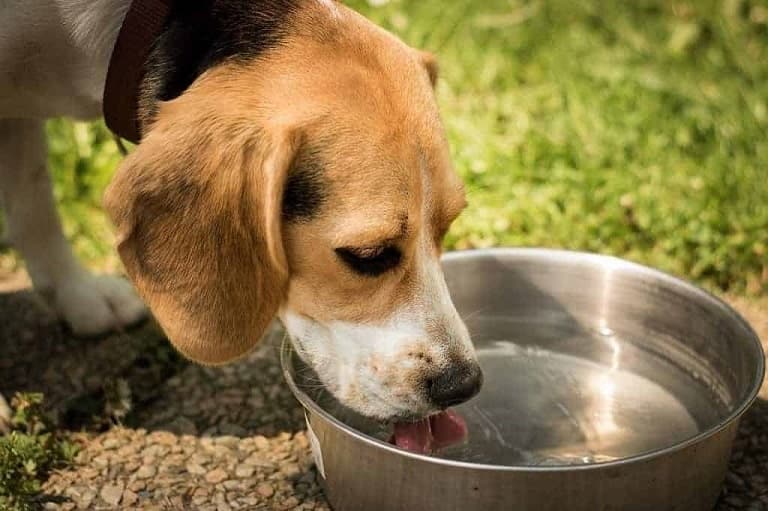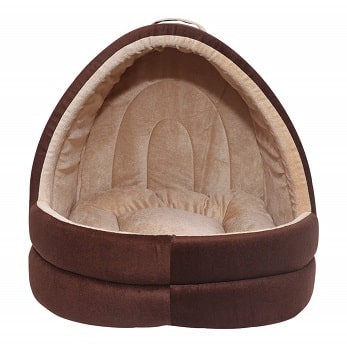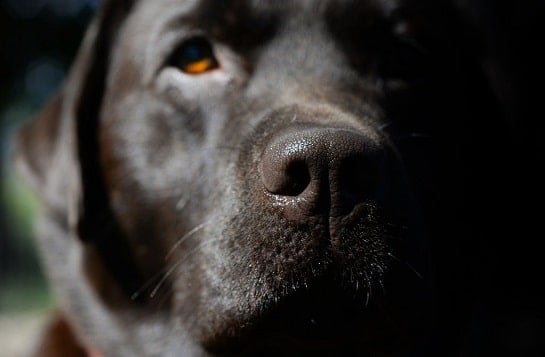How Much Water Should A Dog Drink? | June 2024 Best Practices
Water is essential for life!
It is peculiar to know that some dogs instinctively know to drink just the right amount of water according to their needs, while some dogs don’t drink enough water and others drink too much more than what they need.
So the few daily questions that keep bothering you as a dog owner are:
- How much water should a dog drink to stay healthy?
- Have you ever wondered how much water is too much for a dog?
- How many times a day should I give my dog water?
- Do you think he will drink the same amount he needs at all times?
- What should I do to avoid dehydration in dogs?
It may be possible that your dog is either under-hydrated or over-hydrated.
As a pet dog parent, keeping an eye on your dog’s water consumption is very important. The amount of water your dog drinks can be an indicator of an underlying illness.
A lesser intake of water can result in dehydration, urinary tract issues like kidney stones, organ failure, and even death, in acute cases.
Similarly, drinking too much water can result in stomach bloat, electrolyte imbalances, or Hyponatremia in dogs (water toxicity).
Here are the general guidelines about how much water is too much for a dog and how to get your dog to drink more water to prevent dehydration in dogs if they are not taking in enough.
Why Water is Important for a Dog or a Puppy?
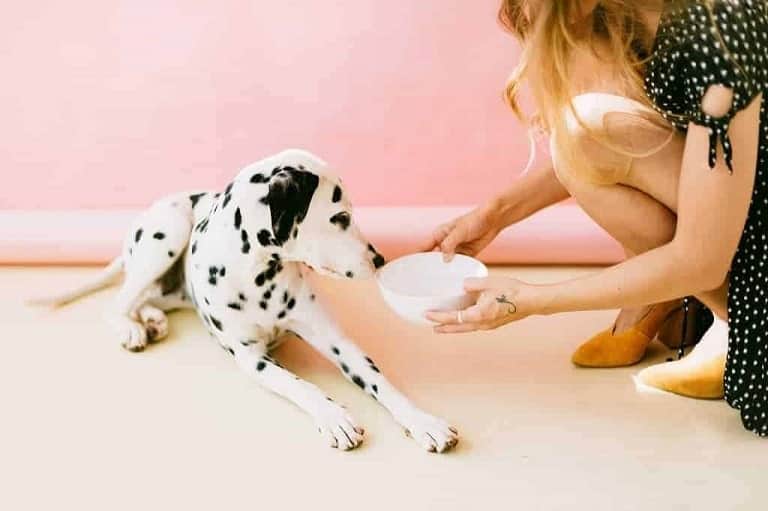
Alike humans, water is an indispensable part of a dog’s body and critical to good health and well-being.
Water is essential for the proper functioning of all cellular, organs, and tissues of the body.
Staying hydrated is important for overall good health as water moisturizes the air in the lungs, and transports oxygen and nutrients in the bloodstream to cells.
Water aids in regulating the body temperature, helps in the protection and lubrication of joints, helps in eliminating waste from the body, and supports the functioning of the nervous system.
Never deprive your dog or any dog of water.
Water content in a dog’s body is not static but a constant and dynamic process. Dog’s intake of water is primarily from drinking water and also from water content in food.
Dogs lose water normally through breathing, panting, drooling, urine, and bowel movements. And abnormally through diarrhea, vomiting, or blood loss.
Lesser intake of water can lead to dehydration in dogs, kidney stones, organ failure, and even death, in acute cases.
Similarly, drinking too much water can result in stomach bloat, electrolyte imbalances, or Hyponatremia in dogs (water toxicity).
This brings us to the question, how much water should your dog, or puppy, drink in a day?
How Much Water Should A Dog Drink Per Day? | Best Practices
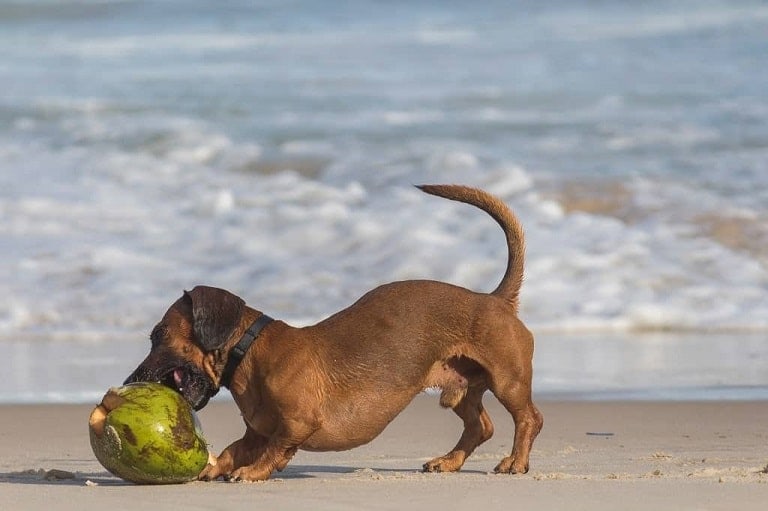
There are various ways to determine how much water should a dog drink.
A dog should, as a general rule of thumb, drink approximately 1 ounce of water, i.e. 1/8th of a cup, per pound of body weight each day.
A general traditional rule for how much water should a dog have is “one ounce (~29.57ml) of water per pound (~453.59 gm) of body weight per day”.
Thus, it means a dog weighing 10 Kg should have roughly 650 ml of water per day; and a dog weighing 35 Kg should have roughly 2.25 L of water per day.
It is never necessary to measure the precise quantity of water your dog drinks on a daily basis, until unless directed by your Veterinarian,
As a dog parent, you should make sure that your dog has plenty of clean and fresh water for his everyday intake.
There are several factors that can affect how much water should a dog have and this amount may vary from dog to dog.
General Guidelines for Water Consumption
There are many factors to consider when monitoring your dog’s water intake such as their size & weight, food & diet, age & growth, and exercise & activity level apart from the surrounding weather conditions.
We summarise the general guidelines, which may be of good help in finding how much water should a dog drink daily and monitoring the average daily intake of water:
- Size & Weight – If your dog is a large breed dog, he would generally require more amount of water as compared to a dog of a small breed. The intake of water is also directly proportional to the weight of a dog.
- Food & Diet – If your dog is eating moisture-rich wet food or homemade food, his water intake will be less than the average daily intake due to the higher water content in the diet, which partially meets the water need of the body. On the contrary, if your dog is eating just dry food or kibble, he will need more water than the average daily intake to compensate for the lack of moisture in the diet.
- Age & Growth – If you have a very young puppy, his hydration need would be fulfilled from his mother’s milk. As and when he is being weaned and starting to eat solid food, he will need a small amount of water every couple of hours. A growing puppy drinks more water than its adult counterpart. You will want to monitor and encourage your puppy to make sure that he is drinking enough water but not too much. In the case of older dogs, which will tend to naturally control their water intake, kindly use the guide by their size to ensure they are drinking enough water.
- Exercise & Activity Level – After a period of hard play or exercise, please use caution when your dog rehydrates. In case, he immediately gulps the entire water from the bowl, then it is advisable to rest him for a bit before you refill the bowl. Also, to reduce bloating after your dog has exercised, you can give him a few ice cubes, to begin with, and then just a little water at a time. If your dog is very active and exercising outdoors, it is always a good idea to bring water along with you so that you can give him frequent short water breaks to keep him hydrated. It should be noted that a lactating dog, a dog on heat, or an active dog mostly drinks more water than other adults.
- Weather Conditions – During summer and warmer months of the year, to reduce the body temperature, you may see your dog panting. Panting helps keep a dog cool by releasing water through respiration, which results in the loss of water through the tongue. To compensate for the loss of water and to avoid dehydration in dogs, your dog may also need to increase their overall water intake more than usual.
- Medications – Certain anti-inflammatory drugs, heart failure drugs, and seizure medications can lead to excessive urination and a compensatory increase in thirst in a dog. If your dog is on medication, it would be advisable to discuss with your vet whether you need to increase or decrease your dog’s water intake.
- Disease – Some diseases such as kidney disease or diabetes can cause an increased thirst in dogs. If your dog is not well from any underlying disease or has mobility or a pain issue, he might not drink the required amount of water. If you’re worried that your dog is either drinking too much or not drinking enough, don’t wait, give your vet a call to establish the exact reason.
How to Check for Dehydration in Dogs?
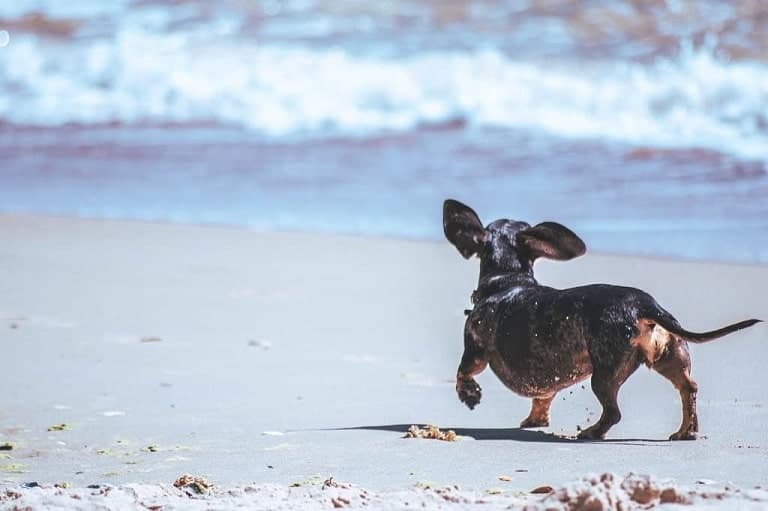
We must discuss dehydration in dogs and over-hydration when trying to ascertain how much water should a dog drink.
There are various tests and checks, enlisted below, which you can undertake to find out if your dog is hydrated or dehydrated:
- One of the easiest tests, to look for dehydration in dogs, is to grab a piece of skin at the back (called scruff) of your dog’s neck, stretch it out, and then let it go. A properly hydrated dog’s skin will snap quickly back into place, whereas in case of dehydration in dogs the skin will return slowly and form a sort of a tent (skin fold). Thus, a well-hydrated dog has good skin elasticity and a dehydrated will have a reduced elasticity.
- Another method to find dehydration in dogs is to check your dog’s gums. Try to gently press on your dog’s gums with your finger until the pressure creates a light little spot and then release your finger, the normal color should come back. A properly hydrated dog’s gum will be moist, pink, slick, and healthy, whereas a dehydrated dog’s gum will be dark, dry, dull, and sticky.
- A hydrated dog displays a good energy level and has bright shiny eyes; whereas a dehydrated dog may be lethargic, look depressed, and has dull & recessed sunken eyeballs. Also, a dehydrated dog’s saliva is sticky or thick like a rope, and may have a dry nose and dry mouth.
- A hydrated dog’s urine is usually odorless and pale yellow or clear; whereas a dehydrated dog’s urine, even with normal kidneys, smells strong and is dark yellow.
Hot summer days, play, exercise, illness, infection – all these can lead to dehydration in dogs and trigger them to seek water.
Apart from this overheating, fever, excessive urination, diarrhea, or vomiting can also cause dehydration in dogs.
Lesser intake of water can lead to dehydration in dogs, kidney stones, liver & other organ failure, metabolic disorders, and even death, in acute cases.
Dehydration in dogs can quickly turn life-threatening. So, if you suspect your dog is very dehydrated, seek veterinary care immediately.
How to Check for Over-hydration in Dogs?
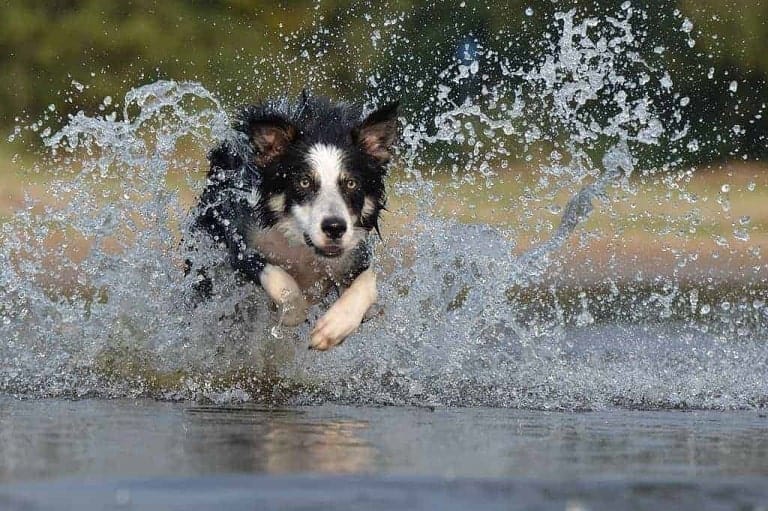
If your dog is drinking too much water, he may have a case of Polydipsia, the desire to drink too much water.
Polydipsia can cause stomach bloating, electrolyte imbalances, and water toxicity (Hyponatremia in dogs).
A dog may be drinking too much water because of diabetes, infection of the uterus, or a kidney issue and can easily over-hydrate, by drinking too much water while playing in water or swimming.
An over-hydrated dog will often vomit and show signs of confusion, and lethargy.
Some of the significant symptoms of over-hydration (water intoxication) include staggering/loss of coordination, lethargy, nausea, bloating, vomiting, dilated pupils, glazed eyes, light/pale gum color, and excessive salivation.
In severe cases, there can also be difficulty breathing, collapse, loss of consciousness, seizures, coma, and death.
If you suspect your dog is over-hydrated or exhibiting any of these symptoms, contact your veterinarian as soon as possible.
How to Ensure Proper Hydration in Dogs?
Lesser intake of water can lead to dehydration in dogs, kidney stones, liver & other organ failure, metabolic disorders, and even death, in acute cases.
Similarly, drinking too much water can result in stomach bloat, electrolyte imbalances, or Hyponatremia in dogs (water toxicity).
Now that we have already discussed how much water should a dog or a puppy have in a day, let’s talk about how to manage the under-drinkers and the over-drinkers.
There are a few strategic methods you can start implementing at home for your dog to change the behavior of their drinking habits, which can help improve his overall water intake:
Under-Drinkers
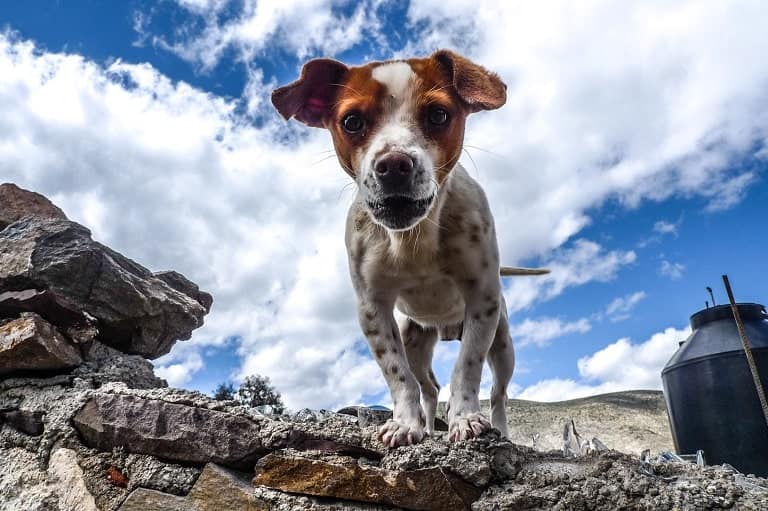
- Behavioral Modification: Whenever your dog goes to get a drink, reward your dog with a treat, and give verbal praise after they take a drink.
- Strategic Placement: Try keeping the water bowl for your dog near his bed or near his food bowl. Also, keep several bowls of water in different parts of the house based on proximity to their sitting, playing, or resting places.
- Add Some Flavour: Add yummy flavorings like chicken broth, bone broth, blended boiled egg, liver gravy, or boiled vegetables in your dog’s water bowl to make it more enticing. You may also up the flavor by adding a sprinkle of food toppers such as Pedigree’s Grilled Liver Chunks Flavour in Gravy with Vegetables or Pedigree’s Chicken & Liver Chunks in Gravy to your dog’s water bowl. You may also use Drools Absolute Salmon Oil Syrup to tempt your dog to drink more water. This oil is packed with Omega-3 and Omega-6 fatty acids which also help in nourishing a canine’s skin and developing the furry coat. your fur baby could be enticed to taste from its water bowl. There is another option of using Zesty Paws Probiotic Bone Broth Food Topper for Dogs, which besides aiding in promoting daily digestive health, also contains a mixture of pumpkin and ginger, to provide additional support for dogs with upset stomachs, diarrhea, and irregularity.
- Feed Wet Food: Add fresh water directly to the dog’s food, kibble, cooked, or raw, and also supplement your dog’s meal with canned wet foods to meet the water requirement of the body. And finally, but most importantly, if you’re feeding only Dry Dog Food, switch to canned and then to a balanced raw diet to greatly increase the amount of water your dog is getting from each meal. You can find a wide variety of Wet Food for Dogs here.
- Use Water Fountain: If possible, do consider getting a dog to drink the water fountain as a further temptation for your dog to have more water. Make it a game or a playful activity with lots of verbal praises and treats.
- Change Bowls: In some cases, changing containers of different shapes (bowls, plates, saucers) or different materials (stainless steel, glass, ceramic) or different sizes, different colors, or placed at different locations, can work wonders in meeting the water intake requirement. Pets Empire Stainless Steel Dog Bowl, Meat Up Stainless Steel Dog Feeding Bowl, and Trixie Ceramic Bowl provide a healthy alternative to plastic bowls and is safe for your four-paw companion, can be used alternatively for a change. You can find here a wide selection of Dog Bowls for your furry friend.
- Clean Bowls: You should take care to wash the bowls often and make sure the water is fresh and clean every day. A dog owner must ensure freshwater availability around the clock for their dogs to attain optimal hydration.
- Normal Water: Always serve clean and fresh water at room temperature, instead of cold.
- Feed Ice Cubes: Do offer your dog some ice cubes as they can be great fun. Some dogs love to chew on ice cubes and this is another way to increase water intake.
- Make him feel Thirsty: Indulge in short frequent fetch or run activities to make your dog have some exercise and feel thirsty. This will keep him motivated to have more water.
- Consult Veterinarian or Healthcare Specialist: It is of paramount importance to note that if all the efforts are still not motivating your dog to have more water, care should be taken to consult a Veterinarian or Healthcare Specialist, without any delay. A dog owner’s motivational exercise should never extend too long and a piece of timely advice should be taken.
Over-Drinkers
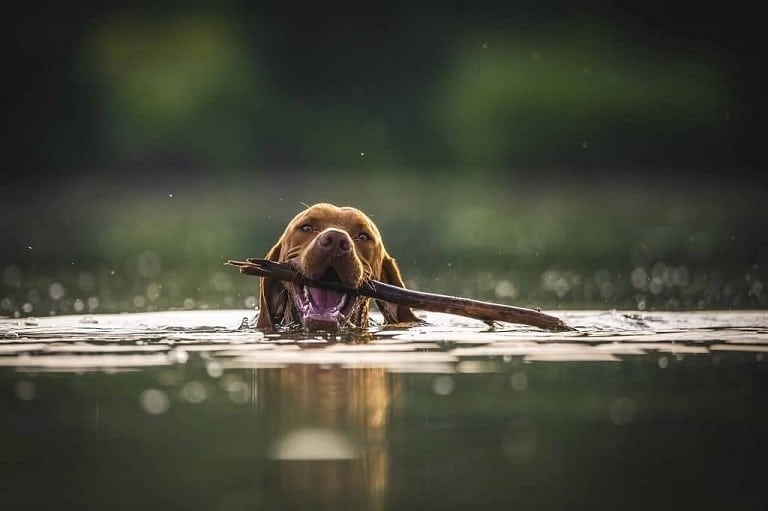
- Avoid Gulp & Encourage Lick: “No Gulp” water bowls or “Lick” bottles can limit the amount of how much water your dog takes in each lick. This can avoid them from drinking too quickly, which leads to bloating. Also, you can monitor the amount they are drinking easily. You can use either Simxen Dog Water Bowl Bottle Sipper or Foodie Puppies Sipper Bottle to reduce the gulp of water to sips.
- Ration it out: During the day, try to ration the water requirement by only filling up the bowl by a quarter or half. This does mean that you will have to fill it up several times throughout the day; however, you can closely monitor the amount he intakes.
- Automate it: Use an automatic feeder, the kind that opens separate compartments at specified times. It is better not to utilize automatic water dispensers as the problem with most of them is that they fill up whenever the water gets low, so you can’t control the amount.
- Use Water Feeder: For better nighttime control, you can place a water feeder in the puppy’s crate. This gives access to water but limits it to sips, rather than gulps, which is good for manually controlling water intake in the case of puppies and growing dogs. You can choose from THE DDS STORE Pet Supply Automatic Water Feeder or Foodie Puppies Pets Automatic Drinking Water Feeder Bottle.
- Consult Veterinarian or Healthcare Specialist: It is of paramount importance to note that if all the efforts are still not able to control the water intake of your dog to normal, care should be taken to consult a Veterinarian or Healthcare Specialist, without any delay. A dog owner’s motivational exercise should never extend too long and a piece of timely advice should be taken.
Conclusion – How Much Water Should A Dog Drink A Day?
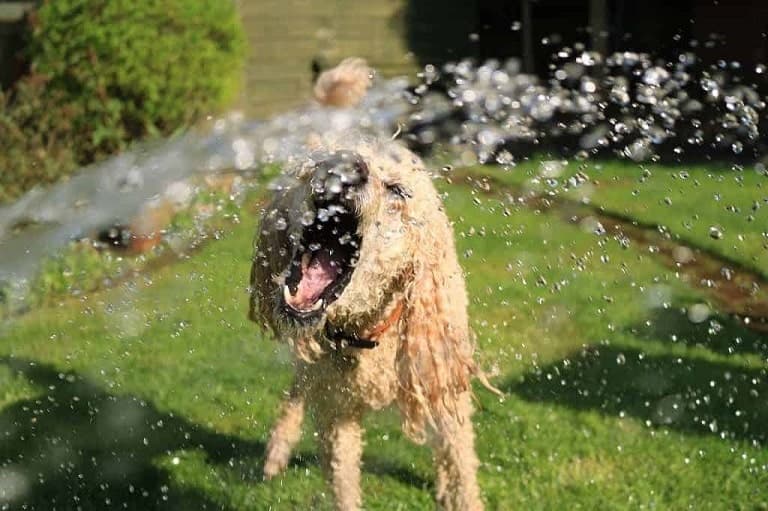
Water is an indispensable part of a dog’s body and critical to good health and well-being. Never deprive your dog or any dog of water.
Water is essential for the proper functioning of all cellular, organs, and tissues of the body.
Yet, some dogs drink just the right amount of water according to their needs, some dogs don’t drink enough water and others drink too much more than what they need.
The most general and basic rule is:
A dog should have one ounce (29.57ml) of water per pound (453.59 gm) of body weight per day.
There are also many factors to consider when monitoring your dog’s water intake such as their size & weight, food & diet, age, and exercise & activity level apart from the surrounding weather conditions.
So, keeping an eye on your dog’s water consumption and monitoring water intake is very important and should become a part of your routine daily care as lesser intake can result in dehydration, and drinking too much water can result in water toxicity (Hyponatremia in dogs).
And if your dog is either not drinking enough water or is having too much water, and if you feel it needs immediate medical treatment, don’t wait, we would request you to kindly contact your veterinarian, without any delay, to rule out an underlying condition.
If you have recently added a puppy to your home then the sheer joy of having a new puppy brings with it so many responsibilities.
You have to decide what food to use, which toys are safe and fun, how to housetrain him, how to teach him about the house rules and so much more.
But monitoring water intake is just as important and should become a part of your routine daily care.
“Water, taken in moderation, cannot hurt anybody.”
~ Mark Twain
Proper hydration contributes to your puppy’s overall health and well-being. Please try to ensure that a just and optimal level of hydration is always maintained.
Frequently Asked Questions
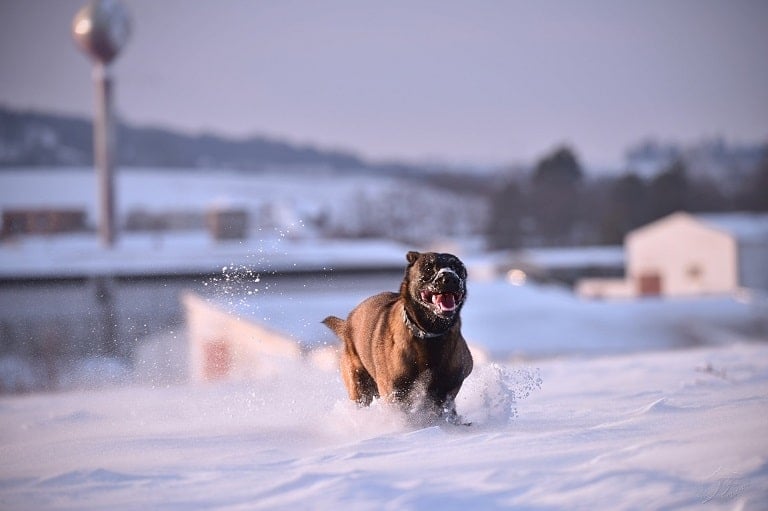
How much water should a dog drink per kg?
A good thumb rule is to make sure that your dog gets at least 1 ounce of water daily for each pound of their weight.
In other words, your dog should drink approximately one ounce of water, i.e. 1/8th of a cup per pound of body weight each day.
You should ensure that your dog is getting between 60ml and 80ml of clean and fresh water per day per Kg of his body weight.
How can I encourage my dog or puppy to drink more water?
There are a few tips that can motivate and encourage your dog to drink more water. Always take care to wash the bowls often and make sure the water is fresh and clean every day.
Place the water bowl for your dog near his bed or near his food bowl. Try rewarding your dog with a treat and praise after they take a drink.
Add yummy flavorings like chicken broth, bone broth, blended boiled egg, liver gravy, or boiled vegetables to your dog’s water bowl to make it more tempting.
Also, add fresh water directly to your dog’s food and kibble and also supplement your dog’s meal with canned wet foods. Do offer your dog some ice cubes as they can be great fun.
How much water should a dog have daily?
Your dog should drink approximately one ounce of water, i.e. 1/8th of a cup per pound of body weight each day.
You should ensure that your dog is getting between 60ml and 80ml of clean and fresh water per day per Kg of his body weight.
So, if your dog is weighing 10 Kg, you should give around 650 ml of water per day. In case your dog is weighing 35 Kg, you should give around 2.25 L of water per day.
The quantum of daily intake of water may vary depending on the kind of food, activity level, age of your dog, health conditions, and also weather conditions.
When should I consult a Veterinarian?
As a responsible owner of a dog, one has to always keep an eye on your dog’s water consumption and monitor water intake.
It is of paramount importance and should be a part of routine daily care. Lesser intake of water can lead to dehydration in dogs, kidney stones, organ failure, and even death, in acute cases.
There are various tests and checks to look for dehydration in dogs, like reduced elasticity of the skin, dark & dry gum, sticky or rope-like thick saliva, strong smell, and dark yellow color of urine.
Some of the significant symptoms of over-hydration (water intoxication – Hyponatremia in dogs) include staggering/loss of coordination, lethargy, nausea, bloating, vomiting, dilated pupils, glazed eyes, light/pale gum color, and excessive salivation.
In severe cases, there can also be difficulty breathing, collapse, loss of consciousness, seizures, coma, and death.
So, if your dog is either not drinking enough water or is having too much water, and if you find any of the above symptoms in either case, you should call for immediate medical treatment, and contact your veterinarian, without any delay, to rule out an underlying condition.
What is the right or correct amount of water my dog should drink daily?
A general traditional rule for how much water should a dog have is one ounce (~29.57ml) of water per pound (~453.59 gm) of body weight per day.
What happens if my dog doesn’t get enough water?
Many important body functions require adequate water; and without enough water supply, your dog can get dehydrated and become quickly ill.
Lesser intake of water can lead to dehydration in dogs, kidney stones, liver & other organ failure, metabolic disorders, and even death, in acute cases.
Organs will eventually become damaged with sustained water deficiency. And if sustained for a longer period, dehydration in dogs can quickly turn life-threatening.
As a precautionary method, you should always take steps to reduce dehydration in dogs and if you suspect that your dog is very dehydrated, you must seek veterinary care immediately.
How much water is too much for a dog?
To answer how much water is too much for a dog please note that it is not necessary to measure the precise quantity of water your dog drinks on a daily basis, unless directed by your Veterinarian.
You should make sure that your dog has plenty of clean and fresh water for his everyday intake between 60ml and 80ml per Kg of his body weight.
How Much Water Should A Dog Drink? | June 2024 | A Quick Snapshot
- Feed Wet Food
- Change the Bowls | Buy More Bowls
- Strategic Placement of Fresh Water Bowls
- Behavioral Modification
- Add Some Flavour to the Water | Make the Water Taste Better
- Clean Bowls
- Buy and Use a Fun Dog Water Fountain
- Serve Normal, Clean, and Fresh Water
- Feed Ice Cubes
- Make him Feel Thirsty
- Consult Your Local Veterinarian or Healthcare Specialist
Dog Products You May Be Interested In
Keep Reading More
Whilst you are perusing this, you may also like to read our additional articles that may be of interest:
How To Encourage A Dog To Drink More Water?
Found this article helpful? Share this article or comment below.
